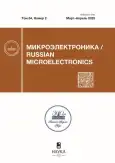Electrical characteristics of ruthenium lines with a cross-sectional area less than 1000 nm2
- Авторлар: Glaz O.G.1,2, Rogozhin A.E.1
-
Мекемелер:
- Kurchatov Institute
- Moscow Power Engineering Institute
- Шығарылым: Том 54, № 2 (2025)
- Беттер: 139-151
- Бөлім: NANOSTRUCTURES
- URL: https://rjsvd.com/0544-1269/article/view/687116
- DOI: https://doi.org/10.31857/S0544126925020048
- EDN: https://elibrary.ru/FUXGCY
- ID: 687116
Дәйексөз келтіру
Аннотация
As the IC scales, it becomes necessary to form lines with a width of less than 20 nm at the lower levels of the metallization system. Copper at such sizes ceases to meet the requirements for RC delays and resistance to electromigration. Therefore, it is necessary to look for alternative materials to replace copper, which will provide higher resistance to electromigration and lower resistance of the lines. The most promising candidate is Ru. In this study, test structures with ruthenium lines were obtained. For this purpose, such methods of creating structures as plasma-stimulated deposition from the gas phase, plasma-stimulated atomic layer deposition, magnetron sputtering, electron beam lithography, and plasma chemical etching were used. Spectroscopic ellipsometry and scanning electron microscopy were used to control the creation and investigation of the resulting structures. The electrical characteristics of the structures were measured and tested.
Негізгі сөздер
Толық мәтін
Авторлар туралы
O. Glaz
Kurchatov Institute; Moscow Power Engineering Institute
Хат алмасуға жауапты Автор.
Email: glaz@ftian.ru
Ресей, Moscow; Moscow
A. Rogozhin
Kurchatov Institute
Email: rogozhin@ftian.ru
Ресей, Moscow
Әдебиет тізімі
- Kapur P., McVittie J.P., Saraswat K.C. Technology and reliability constrained future copper interconnects. I. Resistance modeling // IEEE Transactions on Electron Devices. – 2002. – Т. 49. – № 4. – С. 590–597.
- Gall D. The search for the most conductive metal for narrow interconnect lines // Journal of Applied Physics. – 2020. – Т. 127. – № 5.
- Kamineni V., Raymond M., Siddiqui S., Mont F., Tsai S., Niu C., L’Herron B. IEEE International Interconnect Technology Conference / Advanced Metallization Conference (IITC, AMC) // IEEE International Interconnect Technology Conference IITC. – Ieee, 2016. – С. 105.
- Wen L.G., Cui Y., Kuwahara Y., Mori K., Yamashita H. Atomic layer deposition of ruthenium with TiN interface for sub-10 nm advanced interconnects beyond copper // ACS applied materials & interfaces. – 2016. – Т. 8. – № 39. – С. 26119–26125.
- Fan S.S.C., Chen J.H.C., Kamineni V.K., Zhang X., Raymond M., and Labelle C. IEEE International Interconnect Technology Conference (IITC) // IEEE. – 2017. – Т. 2017. – С. 1–3.
- Nogami T., Patlolla R., Kelly J., Briggs B., Huang H., Demarest J., Paruchuri V. Cobalt/copper composite interconnects for line resistance reduction in both fine and wide lines // 2017 IEEE International Interconnect Technology Conference (IITC). – IEEE, 2017. – С. 1–3.
- Wan D., Paolillo S., Rassoul N., Kotowska B.K., Blanco V., Adelmann C., Lazzarino F., Ercken M. Subtractive etch of ruthenium for sub-5nm interconnect // 2018 IEEE International Interconnect Technology Conference (IITC). – IEEE, 2018. – С. 10–12.
- Van der Veen M.H., Heylen N., Varela Pedreira O., Ciofi I., Decoster S., Gonzalez V. Vega, Jourdan N., Struyf H., Croes K., Wilson C.J., Tőkei Zs. Damascene benchmark of Ru, Co and Cu in scaled dimensions // 2018 IEEE International Interconnect Technology Conference (IITC). – IEEE, 2018. – С. 172–174.
Қосымша файлдар


























